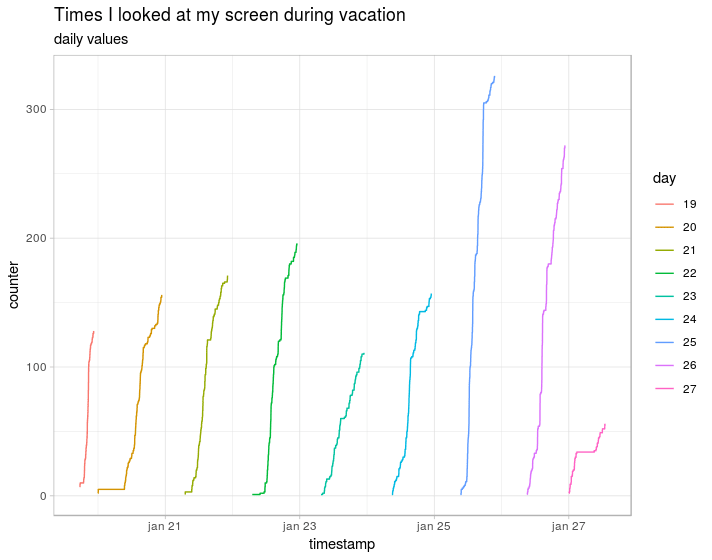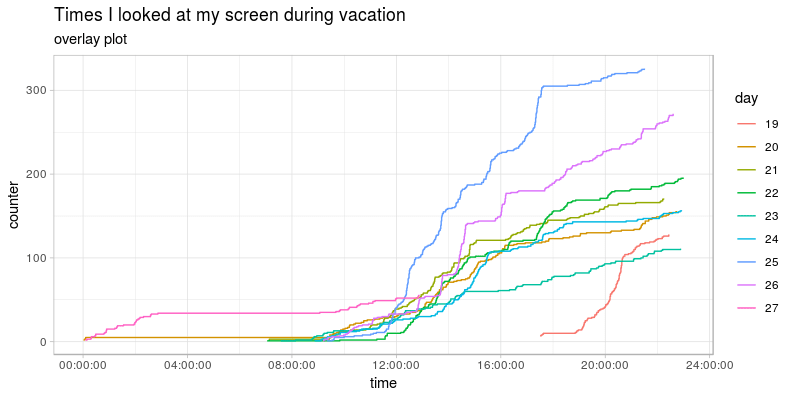How many times do I look at my phone? I set up a small program on my phoneto count the screen activations and logged to a file. In this post I showwhat went wrong and how to plot the results.
The data
I set up a small program on my phone that counts every day how many times I usemy phone (to be specific, it counts the times the screen has been activated).
My data looks like this:
"screen_log";"1-19-19";"17.30";"7"
"screen_log";"1-19-19";"17.33";"8"
"screen_log";"1-19-19";"17.36";"9"
"screen_log";"1-19-19";"17.38";"10"
To account for comma use and possible problems I set up the program on myphone to write a “;”-seperated file that records screen_log, the date, thetime and the current value of screen_count. Every day around 12 o clock it resetthe counter to 0.I thought it would be cool to compare different days.
The problems
I started the data collection on januari 19th around 17:00h, so the first dayis already halfway through.For reasons I cannot fathom, sometimes the system date is recorded in the USAstyle MONTH-DAY-YEAR and sometimes in the rest-of-the-world style of DAY-MONTH-YEAR.I wish I could set it to YEAR-MONTH-DAY (ISO 8601).
Reading in the data
I use read_csv2, which expects “;” as a seperator and never converts text to factor.This particular textfile has no headers, so I tell R what to call the columns.
library(tidyverse) # what else
screenlog <- read_csv2("data/screenlog.csv",col_names = c("type","date","time","counter"))
Data cleaning
I have to deal with the different time formats, so I set up a regex that worksonly with Januari, if it detects -01-19 it pulls out the numbers before that,if it detects the other variant it takes the second part.I combine the date and time into a timestamp and pull out the hours and minutes,before combining the hours and minutes into HMS time class.Finally I remove anything over 23 hours, because in that period the counter isreset.
screenlog <-
screenlog %>%
mutate(
day = case_when(
str_detect(date, "[0-9]{1,2}-01-19") ~
str_replace(date, "([0-9]{1,2})-01-19","\\1"),
str_detect(date, "1-[0-9]{1,2}-19") ~
str_replace(date, "1-([0-9]{1,2})-19", "\\1") ,
TRUE ~ NA_character_
),
timestamp = paste0("2019-01-",day, " ",time),
timestamp = as.POSIXct(timestamp,tz = "GMT", format = "%Y-%m-%d %H.%M"),
hours = str_replace(time,"\\.[0-9]{1,2}", "") %>% as.numeric(),
minutes = str_replace(time,"[0-9]{1,2}\\.", "") %>% as.numeric(),
time = hms::hms(hours = hours, minutes = minutes)
) %>%
filter(hours < 23)
How does it look?
First an overview:
screenlog %>%
ggplot(aes(timestamp, counter, color = day))+
geom_step()+
ggtitle("Times I looked at my screen during vacation", subtitle = "daily values")+
theme_light()
Daily cumulative screen looking values
But that is difficult to compare, so I also show them overlayed:
screenlog %>%
ggplot(aes(time, counter, group = day, color = day))+
geom_step()+
ggtitle("Times I looked at my screen during vacation", subtitle = "overlay plot")+
theme_light()
overlay of cumulative screen lookings every day on the same hourly scale
Fin
The only remaining question is: what did I do on the 25th that I looked soooo (326 times) manytimes on my screen?Is there a bug in the counting? Was I really bored, did I take a lot of photo’s?I was in the Botanical Gardens of Malaga and did take a lot of pictures with myphone.






Top comments (0)